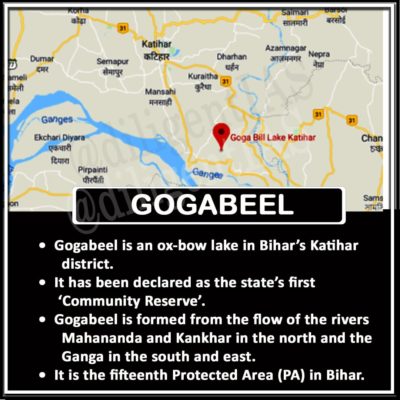Gogabeel, an ox-bow lake is Bihar’s first community reserve 13/08/2019 – Posted in: Daily News – Tags: 'Community Reserve' and 'Conservation Reserve', waterbodies
GOGABEEL IS BIHAR’S FIRST COMMUNITY RESERVE
For: Preliminary & Mains
Topics covered: Gogabeel, Community Reserve, Conservation Reserve
News Flash
Gogabeel, an ox-bow lake in Bihar’s Katihar district, has been declared as the state’s first ‘Community Reserve’.
- The water body was notified as a 57 hectare Community Reserve and a 30-hectare ‘Conservation Reserve’.
- Gogabeel is formed from the flow of the rivers Mahananda and Kankhar in the north and the Ganga in the south and east.
- It is the fifteenth Protected Area (PA) in Bihar.
‘Community Reserve’ and ‘Conservation Reserve’Conservation reserves and community reserves in India are terms denoting protected areas of India which typically act as buffer zones to or connectors and migration corridors between established national parks, wildlife sanctuaries and reserved and protected forests of India. Such areas are designated as conservation areas if they are uninhabited and completely owned by the Government of India but used for subsistence by communities and community areas if part of the lands are privately owned. These protected area categories were first introduced in the Wildlife (Protection) Amendment Act of 2002 − the amendment to the Wildlife Protection Act of 1972. |
Background
- Gogabeel was initially notified as a ‘Closed Area’ by the state government in the year 1990 for five years.
- This status was extended in 1995, up to 2000.
- After the amendment of the Wild Life (Protection) Act, 1972, in 2002, the provision of ‘Closed Area’ was omitted and this site disappeared from the list of the Bihar government’s PAs, having no legal status.
- In 2004, Gogabeel, including the neighbouring Baghar Beel and Baldia Chaur, were given the status of an IBA (Important Bird Area of India) by the IBCN.
- In 2017, IBCN again declared Gogabeel as an IBA.
Bird Paradise
- Gogabeel is a permanent waterbody, although it shrinks to some extent in the summer but never dries completely.
- More than 90 bird species have been recorded from this site, of which, about 30 are migratory.
- Among the threatened species, the Lesser Adjutant Stork is listed as ‘Vulnerable’ by the IUCN while the Black Necked Stork, White Ibis and White-eyed Pochard are ‘Near Threatened’.
- Other species reported from this site include Black Ibis, Ashy Swallow Shrike, Jungle Babbler, Bank Myna, Red Munia, Northern Lapwing and Spotbill Duck.
Source: Down To Earth
Also, read more daily News
- Pradhan Mantri Kisan Urja Suraksha evam Utthaan Mahabhiyan (PM-Kusum)
- New GDP series to align with Global Method
- Lake “Kajin Sara”
- Reusable Rockets
- Henley Passport Index 2019
You are on the Best Online IAS preparation platform. You are learning under experts.
We are present on Facebook- Diligent IAS, LinkedIn- Diligent IAS, YouTube- Diligent IAS, Instagram- Diligent IAS. Get in touch with us

